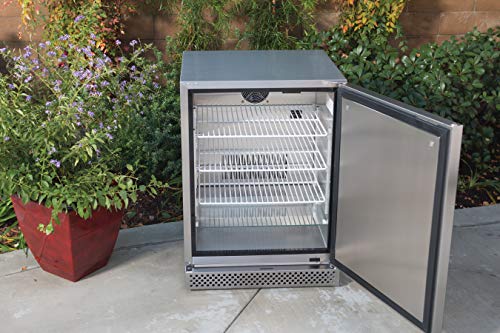Outdoor refrigerators make excellent additions to outdoor kitchens for all the right reasons in the world. It doesn’t matter what function you are having – barbecue parties, hangouts, reunions, or camping activities – an outdoor refrigerator is often useful.
But why can’t you buy a regular refrigerator for your outdoor space or move the one in your house outdoors? Well, even though the primary function of every refrigerator is to chill food, drinks, and vegetables and keep them fresh, not every refrigerator works well in all kinds of environments.
An indoor refrigerator will not function as effectively as an outdoor model will in an outdoor setting. This is why outdoor refrigerators are being manufactured.
Moreover, because of the fluctuating temperatures that exist outdoors, a refrigerator placed outside will work harder to get foods and drinks cold. And unlike indoor models, outdoor refrigerators are specially insulated and made from waterproof materials to prevent the risk of shock or electrocution.
Among other reasons why you may need an outdoor refrigerator, if you plan to do some grilling at an outdoor party, for instance, you can keep your meat fresh in the refrigerator before you grill it. You also don’t have to hurl a cooler of ice around because you need cold drinks at an outdoor event.
All that said, finding an outdoor refrigerator is not as easy as most people think.
More so, not all refrigerators listed on online sites and walk-in shops are actually outdoor refrigerators as some sellers tag them to be. An outdoor refrigerator must be specifically designed for the purpose. It also has to be UL-approved for use in an outdoor setting.
Not to worry, we are here to make the task of finding the right one easy for you.
Come along and let’s show you how.
Table of Contents
Types of Outdoor Refrigerators
There are 2 types of outdoor refrigerators: the built-in outdoor refrigerators and the freestanding outdoor refrigerators.
The Built-in Outdoor Refrigerators are designed to blend seamlessly with your outdoor kitchen furniture. Freestanding Outdoor Refrigerators, on the other hand, can be installed in any space outdoors.
What’s more? While the built-in models have their vents in front and do not really need as much clearance as the freestanding models, the freestanding ones require some clearance all-round. And by all-around, we mean the sides, top, and rear of the refrigerator.
[amalinkspro type=”cta-btn-css” ctabtn-id=”” asin=”B01KW94FZY” apilink=”https://www.amazon.com/dp/B01KW94FZY?tag=refrigeratorsreviewed-20&linkCode=osi&th=1&psc=1″ addtocart=”false” new-window=”true” nofollow=”true” alignment=”aligncenter”]Click here to check out this outdoor-rated refrigerator on Amazon[/amalinkspro]
How to Choose the Best Outdoor Refrigerator
Here are some factors to consider before you buy an outdoor refrigerator:
1. Size and Capacity.
One good thing about outdoor refrigerators is that they are often more compact relative to the refrigerators/freezers found in indoor kitchens.
To be sure that you have the right refrigerator, check the size and storage capacity of the refrigerator based on your available space and how much storage you need.
You may also consider an outdoor refrigerator with drawers for easy access to the items in it.
Also, factor in the possibility of changes in your storage needs as well. If you can envisage a change, then it will help you choose a model that can serve you now and later in the future.
Check out these other articles…
Kenwood Fridge Freezer Not Freezing [Solutions]
Lec Fridge Freezer Not Freezing [Solved]
KitchenAid Refrigerator Dispenser Problems [Solutions]
Neff Freezer Not Freezing [How to Fix]
Indesit Freezer Not Freezing [Quick Fix]
2. Material.
The materials used for outdoor refrigerators differ significantly from the indoor models. However, these materials may vary based on what the manufacturer thinks is best.
In any case, ensure that the material of the outdoor refrigerator that you choose is weather-proof or rust-free. Stainless steel fits conveniently into this type of material. However, not all stainless steel is durable because they are all made differently. This is why we recommend the 18/8 grade which is also referred to as grade 304. This material has a high resistance to corrosion and is durable.
We also advise you to be on the lookout for and avoid the cheap outdoor refrigerators. They are usually made with steel that is plastic-wrapped or grade 430 steel; which is rust-prone.
[amalinkspro type=”cta-btn-css” ctabtn-id=”” asin=”B003TJA9DW” apilink=”https://www.amazon.com/dp/B003TJA9DW?tag=refrigeratorsreviewed-20&linkCode=osi&th=1&psc=1″ addtocart=”false” new-window=”true” nofollow=”true” alignment=”aligncenter”]Click here to check out this outdoor refrigerator on Amazon[/amalinkspro]
3. Features.
Unlike indoor models, outdoor refrigerators come in pretty simple units. Still, they may have features like an adjustable thermostat, levelers, automatic defrost, interior lights, and adjustable shelves. So, it helps to look out for features that you consider necessary before you make a choice.
Also, if you have little ones around you, you may decide to opt for models that have locks for security. The locks are also useful to avoid leaving the refrigerator doors open.
4. Price.
If you are in the market for UL-approved refrigerators like we hope you actually are, then you should plan to pay at least $600 for a good unit. This unit will likely have a plastic door and freezer that defrosts manually. With $700, you can get a sleek unit that is made from stainless steel and has a spacious roomy interior. The only issue with this type is that its freezer compartment is usually quite small.
However, if you are thinking of an exquisite beverage cooler instead, then you should be willing to pay between $900 and $1,800 or more for units that have 2 to 3 drawers.
[amalinkspro type=”cta-btn-css” ctabtn-id=”” asin=”B07CYQCH5D” apilink=”https://www.amazon.com/dp/B07CYQCH5D?tag=refrigeratorsreviewed-20&linkCode=osi&th=1&psc=1″ addtocart=”false” new-window=”true” nofollow=”true” alignment=”aligncenter”]Check out this drawer-style outdoor refrigerator on Amazon[/amalinkspro]
5. Energy Efficiency.
It always helps to have a low energy consumption refrigerator. You get to spend less on maintenance. Plus, you also save some bucks on the electricity bill. According to Energy Star, outdoor units usually cost about $35 every year. Outdoor Refrigerators manufactured by Marvel, for instance, cost an average of $25 each year to run. Other brands may cost more or even as low as 50% of the amount spent on Marvel refrigerators.
Outdoor Refrigerator Not “All-Weather” Refrigerator
It is easy to assume that “outdoor” translates to “all-weather”. This is not true. In fact, there are some users who have had unpleasant experiences with their outdoor fridges because of this assumption.
Even though most outdoor refrigerators are weatherproof, they are constructed that way only to protect the electrical parts of the refrigerator from moisture. That’s all.
So, can you leave your outdoor fridge out in really bad rainstorms? It’s a big NO. You shouldn’t also allow it to function during winter.
With respect to rust and corrosion-resistance, the fact a refrigerator is made from high-grade stainless steel doesn’t mean one should leave the fridge out under harsh weather conditions. Stainless steel also has its limits.

What To Do with Your Outdoor Fridge When the Kitchen Season is Over
First of all, we think it is important to note that outdoor refrigerators don’t work all year round. And like the AC in your car, you don’t want to run it during the winter or what will be the point?
So as soon as the outdoor kitchen season is over it is advisable to remove every item in the fridge and disconnect it from its electric source.
We also recommend leaving the refrigerator door slightly open by propping it. This will allow ample air circulation in the fridge to prevent bacterial growth.
And if you decide to go for a freestanding refrigerator, you may want to cover it up at the end of the season. But to ensure that this is not counterproductive, make the covering a bit lose. This is to avoid trapping moisture in the refrigerator.
Also, be on the lookout for condensation in your outdoor refrigerator during the winter. As soon as you notice anything of the sort, wipe it off with a dry cloth.
How to Maintain An Outdoor Refrigerator
The secret to long-lasting use with the best outdoor refrigerators is proper maintenance. Of course, there’s a reason these refrigerators are specifically designed for outdoor purposes – to withstand the fluctuating temperatures and humidity.
Here are a few ways to maintain your outdoor refrigerator:
1. Keep Your Refrigerator Dry
Like we said earlier, outdoor doesn’t translate to all-weather. Ditch the lie that your outdoor fridge will grow a thick skin to snow, and rain. You are about to lose some good money if you think it will.
Now that we’ve established why an outdoor refrigerator is so-called, it is important to know that one of the ways to extend the lifespan of your refrigerator is to keep it as dry as you possibly can.
Keep it sheltered from the rain and far from the pool or sink, and any source of water around it. Except it is a built-in model, we advise you to take the fridge in when it rains or snows.
You’ll need this tip especially if the fridge you go for is not weatherproof or UL-rated.
Check out these other in-depth articles/reviews…
Bottom Freezer Refrigerators: A Buying Guide
Kegerators: A Complete Buying Guide
How to Install a Swamp Cooler on a Roof
Commercial Refrigerators: How To Buy The Best
2. Keep it Away From Direct Sunlight
It could get really hot during the summertime. And if you’ve been following the trend, you must have noticed that summers keep getting really hot. During the season, if not properly shaded, your refrigerator will feel the heat too. And if you expose it to direct sunlight, things could go really awry.
Here’s how things can go south with your outdoor refrigerator: refrigerators generally work by taking in heat from the environment to release it back into the environment. If the heat gets too much, the process may not proceed properly. This may eventually damage the refrigerator and cost you some money in repairs or an eventual but quick replacement.
What to do? You can install your outdoor fridge between cabinets or build a kitchen island if you don’t have one already. Installing your refrigerator this way will keep it shaded and protect it from direct sunlight.
[amalinkspro type=”cta-btn-css” ctabtn-id=”” asin=”B07DPMTCS7″ apilink=”https://www.amazon.com/dp/B07DPMTCS7?tag=refrigeratorsreviewed-20&linkCode=osi&th=1&psc=1″ addtocart=”false” new-window=”true” nofollow=”true” alignment=”aligncenter”]Check out this outdoor refrigerator on Amazon[/amalinkspro]
3. Keep it Adequately Ventilated
You may not have all the real estate in your outdoor space to build an island kitchen or have cabinets to shade your fridge. In such an instance, you can cover the fridge. But while covering, ensure you allow room for air to circulate.
In absorbing heat from the environment, the refrigerator will need refreshed air around it for the heat to escape. Ample ventilation keeps refreshed air around for this purpose.
Manufacturers know so much about this. That is why even the built-in models have their vents at the front. So, irrespective of where you place it and how many cabinets are beside it, a built-in outdoor fridge will still get ample ventilation.
The freestanding ones, on the other, will require clearance at the top, back, and sides for proper ventilation.
Conclusion
An outdoor refrigerator is a convenient appliance to have during summer and warm climates. Since there are now outdoor refrigerators designed to weather the storm, you no longer have to cancel your outdoor events because you don’t have a reliable cooling unit.
Now that you know what to look out for before you make a purchase, you can go right ahead and select your most preferred choice.
Up for a challenge? Check out the video below for tips on how to build an outdoor mini bar.
Get Instant Help — Ask An Experienced Verified Appliance Technician
Need expert help? Click here to use the chat box on this page to speak with a verified appliance technician right away. No need for expensive in-home service calls. No appointments. No waiting.




